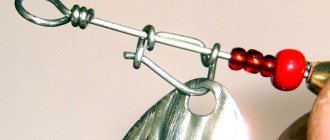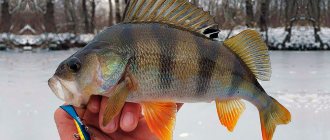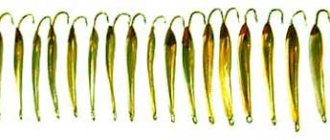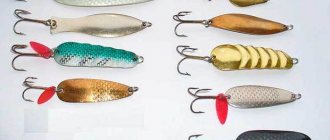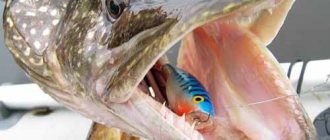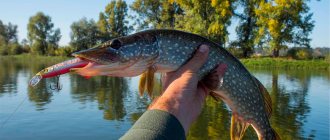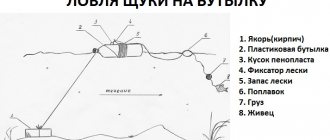Spinnerbaits appeared in our area much later than classic spinners, but they have already established themselves as excellent baits and have gained recognition from many spinners.
Spinnerbaits differ from other lures not only in their very original, even exotic design, but also in their excellent maneuverability in difficult areas, which conventional spinners and spinners cannot boast of.
Also note that, compared to various silicone non-hook baits, spinnerbaits have a greater range of action, that is, with their larger body and action they are able to attract predators from a longer distance.
Where to fish with a spinnerbait
Spinnerbaits are used primarily in spinning fishing in small areas of reservoirs with an abundance of aquatic vegetation. It is in overgrown shallow water that pike are often caught standing there in cover.
Often spinnerbaits are effective when fishing at depth, but also close to the shore. It is worth looking for large predators in pits with snags.
Spinnerbaits are characterized by high windage, which is why it is unlikely to be possible to make truly long casts.
However, they are not particularly needed, because these baits are good for fishing at a short distance from the shore.
DIY spinnerbait
Currently, fishing stores offer a large selection of different spinnerbaits. However, some fishermen prefer to make them themselves. To do this, take a rigid wire and make a loop in the middle of it. A loop is made on one side of the wire to attach the bait and sinker. On the other side there will be petals. First you need to put two beads on the wire, then a smaller petal on the clamp. Its convex side should point towards the middle of the wire. Then three more beads are strung and a small loop is made at the end with the petals. A large petal is already attached to it. This is how a homemade spinnerbait is made.
Spinnerbait device
The spinnerbait consists of the following main parts:
- wire rocker;
- weight-head;
- single hook;
- rotating petals (1, 2, or 3 pieces);
- silicone or rubber “skirt”, or silicone bait.
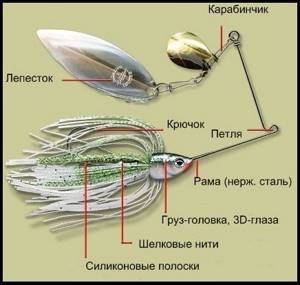
Although the general design of all spinnerbaits is the same, these lures differ from each other in the details. For example, the shape of the wire rocker may vary, the number, size and shape of metal petals, and the type of nozzle may differ.
The traditional “skirt” on the hook is often removed, and instead of it a silicone bait (worm, twister, vibrotail) is attached.
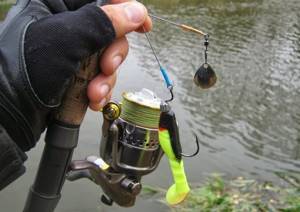
Practice shows that it is active fish who bite on spinnerbaits with two petals more often, while a sluggish, passive predator is better caught on baits with one single petal. For example, for catching active pike in shallow waters, spinnerbaits with a pair of silver petals and a light-colored “skirt” are good, and the back petal should be slightly larger than the front one.
What is a spinnerbait for fishing?
The spinnerbait is an original fishing bait that was invented 100 years ago in the USA, and appeared in our country relatively recently. The name of this bait is derived from the English words spinner - rotating spoon and bait - bait.
The spinnerbait has gained great popularity due to its high catchability and maneuverability, since these are the qualities that make it possible to use it in shallow water in standing water with dense vegetation. Predatory fish, including pike, like to ambush in such places.
The high permeability of the spinnerbait makes it more competitive in comparison with other baits made of plastic and foam rubber, and its attractive appearance and structure make it easy to lure toothy pike and ensure high bite results.
The design of a spinnerbait for pike is quite unusual - it is a thin steel rod, bent in the shape of an L or a rocker. This shape allows you to reduce snags in areas overgrown with thick grass.
Along the edges of the rod and at its bend there are loops, to one of which a fishing line is attached. A rotating petal, which plays the role of bait, and a hook, which is sometimes decorated with bright silicone plumage, are attached to the remaining loops. Sometimes 2 or more petals (spinners) and a silicone “skirt” are attached to the spinnerbait in order to better attract fish. Also, the “skirt” increases the permeability of this fishing bait through overgrown areas of the reservoir.
Tackle for fishing with spinnerbait
To successfully fish with spinnerbaits, you will need a fairly rigid spinning rod, which will allow for proper retrieval.
On the other hand, a stick that is too stiff makes long casting difficult, so it is necessary to find a compromise solution. If you are fishing from the shore, you need a longer rod; if you are fishing from a boat, you need a shorter one. Let us remember that a spinnerbait has a large windage and cannot be cast far.
Approximate parameters when choosing a fishing rod:
- medium tuning,
- length from 2.7 to 3.5 meters
- test in 10-30 g.
There are no special requirements for the reel, the main thing in it is good reliability and a sensitive drag, the reel size is from 2500, the spool is preferably shallow. But it is better to use braided fishing line. Also, be sure to use strong leashes with a length of 13-15 cm, because most often it is the toothed pike that bites on the spinnerbait.
Leaders can be made of titanium, steel or fluorocarbon. Fluorocarbon leaders should be no thinner than 0.4mm. This will protect your line from rubbing against the sharp teeth of the pike.
Advantages of homemade spinnerbaits
Each bait used in fishing certainly has its own advantages and disadvantages. Many experienced fishermen include the following advantages of spinnerbaits:
- High catchability.
- The ability to fish with them in places where other baits can be lost due to a hook.
- Versatility in terms of attracting a wide range of predatory fish species.
- Easy to use.
- Possibility of independent improvement of the design. You can easily replace the petal, skirt and sinker.
The main disadvantage of this bait is its high windage , which should always be taken into account when casting. And another thing is that the silicone “skirt” is often damaged after being bitten by a large predator; it has to be replaced or repaired.

Despite the fact that in fishing stores you can find a large selection of industrially produced spinnerbaits, a certain circle of fishermen prefer to make such baits themselves. Why? There are several good reasons for this:
- Retail outlets offer standard options, which often do not have good catchability.
- Using various components, you can make this bait with improved performance parameters.
- It’s not at all difficult to make a spinnerbait with your own hands, which will meet the requirements of the spinner and is designed for catching a certain type of predator in his favorite body of water.
- A homemade spinnerbait is much cheaper than a purchased one.
- There is already quite a lot of advice on the Internet and in specialized literature on how you can make a spinnerbait with your own hands for perch, pike and other species of predator.
It can also be noted that a self-made spinerbait for perch or other fish can easily be remade within a few seconds , thereby changing the nature of its game, and therefore its effectiveness. It is enough to replace the petal or add a few multi-colored beads.
You can also think about how to make a spinnerbait with your own hands and replace its hook with a skirt with a small wobbler or even a twister. So, by changing the hooking element, you can get a bait with completely different properties .
Expert opinion
Knipovich Nikolai Mikhailovich
Zoologist, hydrobiologist. I am interested in fishing at a professional level.
Interesting! There is a similar design, in which instead of a rotating upper petal, a small rotating stainless steel propeller is installed. This bait is called a “bassbait”.
Some spinning anglers who prefer to fish with light rods using small baits can easily make a miniature bait of this design. For example, a mini spinnerbait for perch is often used, which is made by the fisherman with his own hands.
Spinnerbait colors
The most popular colors for spinnerbaits are white, silver, red and black. They work well in both clear and cloudy water.
An excellent color combination for fishing in clear water is a copper petal and a yellow silicone “skirt”.
For fishing in places with an abundance of grass and algae, nickel-plated petals and spinnerbaits painted with fluorescent paints are suitable. The latter are also indispensable when fishing in very muddy water.
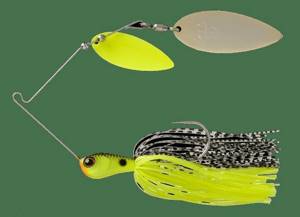
Jig spinnerbait
In addition to the classic ones, you can make a more practical jig spinnerbait. The production of this type of bait is described in detail in one of the episodes of the “Fisherman’s Workshop with the Shcherbakov brothers.” The use of such a spinnerbait is much more practical because it has a fastener on the lower arm of the rocker, which allows you to quickly change the used sinkers and baits. Thus, the fisherman will not need to make several dozen spinnerbaits - it will be quite enough to have 2-3, as well as replaceable baits for them.
Parts and tools
How a Jig Rig is made
To make this type of spinnerbait you must have:
- Steel string with a diameter of 0.8 millimeters;
- Long shaped petal;
- Jig head;
- Silicone bait.
The set of tools for making this type of spinnerbait will also be somewhat different:
- Long nose pliers;
- Soldering iron;
- Wire cutters.
This is where the equipment needed to make a jigging spinnerbait ends. The main advantage in the manufacture of this design is that there is no need to cast a sinker, which speeds up the manufacturing process several times and also reduces the cost of the necessary set of tools.
Manufacturing process
Making a jig spinnerbait for pike using the Shcherbakovs’ method is carried out as follows:
- A piece of string about 30 centimeters long is cut.
- At a distance of approximately 10 centimeters from the upper end, a loop is made using long-nose pliers, and the angle between the arms of the future rocker should be 90 degrees.
- A loop is made at the upper end of the rocker in one turn, as on standard fishing hooks, but is not bent all the way.
- The end of the loop is threaded into the eye of the swivel.
- The edge of the loop is pressed tightly to the base.
- The petal is cut off with pliers from the side in the area of the eye so that the eye of the swivel can be threaded into the hole of the petal.
- The swivel is threaded into the hole of the petal.
- The cut edges of the petal are tightly folded back.
- A standard wire fastener is formed on the lower edge of the rocker arm. The free end of the fastener, when closed, should be directed in the same direction as the upper arm of the rocker so as not to create a snagging element.
- Using a soldering iron, the middle loop of the rocker arm, the swivel fastening loop are spot-soldered, and the cut in the petal is soldered with care so as not to solder the hole.
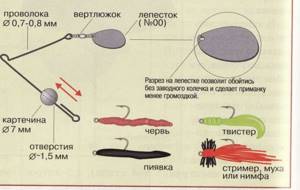
One of the variants of a jig spinnerbait is a design with a non-removable sinker, which allows it to more easily overcome underwater vegetation, but at the same time deprives the angler of the ability to change the weight of the load when fishing conditions change.
At this point, the jig spinnerbait can be considered ready. Using a fastener on the lower arm of the rocker, any jig head with any silicone bait that will be considered promising by the angler is attached to the structure.
Peculiarities
The speed at which the bait falls to the bottom depends on the choice of petal shape. Rotating, it plays the role of a small parachute, slowing down the movement of the jig head. The more elongated the petal is, the less it slows down its fall. Therefore, elongated petals, the shape of which is called long, are usually used when fishing in holes and at great depths, when fishing occurs near the bottom. This allows the spinnerbait to drop faster. Using wider blade options, such as aglia or colorado, will help keep the bait easier in the water column and closer to the surface, which is especially important when fishing for perch.
The thickness of the spinnerbait spinner should be minimal, since a heavy petal attached through a shock-absorbing rocker will not provide the required rotation speed and will contribute to incorrect play of the entire bait. Also, you should not make it too large, since in this bait it is a secondary element.
When fishing for perch, it is worth using a wire of a smaller diameter than when fishing for pike, since a rocker that is too thick can alert the striped predator, while it itself is rarely able to deform the wire. Also, when fishing for this fish, there is no need to make the lower arm of the frame long, since when fishing for pike it primarily serves as a metal leash. That is why this structural element in the pike version is made about twenty centimeters long.
When making spinnerbaits, it is preferable to use an elongated or cone-shaped sinker. The classic round jig head clings to underwater vegetation, which significantly limits the efficiency of movement of this type of bait through difficult places. This is true both in the manufacture of classic spinnerbaits and for jig variations. It is better to use round sinkers only on reservoirs with a clean bottom.
Posting a spinnerbait
An even retrieve is the main method with spinnerbaits, especially when fishing in shallow areas.
Pike are more likely to attack slow-moving bait, so the pace must be appropriate.
To avoid problems with the spinnerbait quickly sinking to the bottom, choose lighter lures with wide blades. If you plan to fish at depth, using a longer cast, you will need a spinnerbait of greater weight.
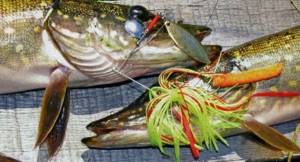
In places where the depth exceeds 1.5-2 m, try stepped wiring, to which both pike and perch can react. The use of the “step” is relevant throughout the warm season, but it brings the best results in May and September-October.
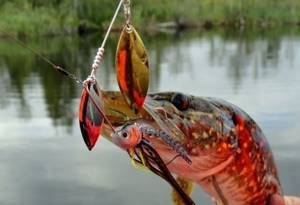
To catch active pike in the summer, they turn to surface fishing, the essence of which is the rapid movement of the bait near the surface. With such a fast retrieve, the blade of the spinnerbait leaves marks on the surface of the water that are clearly visible to the fish. Naturally, a passive predator is unlikely to chase a fast bait, but a hungry pike hunting in the upper horizon may well be interested in such a fast bait.
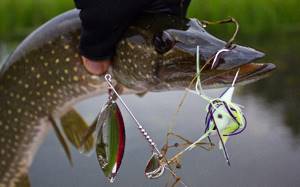
Also, if traditional uniform wiring is unsuccessful, you can diversify it a little with small tricks.
For example, this could be a sharp stop for literally one second, that is, after casting, you lead the bait 5-6 m, then stop abruptly and immediately continue evenly moving.
Sometimes it is precisely such a stop that provokes an attack from a predator following the spinnerbait. You can proceed according to a similar scheme, replacing sharp stops with the same sharp jerks along the course of a slow, uniform drive. In general, you need to experiment, starting from the uniform wiring of the spinnerbait.
What types of spinnerbaits are there?
You can find a spinnerbait that has two or even three petals located one behind the other, and the sizes of the petals can be different. There are baits called “catlers”. Instead of a jig head, they have a silicone bait, such as a “vibrating tail” with a head, like a “horse head”, so that the soft bait has the necessary orientation.
There is also another variety called “buzz bait”. In order for the bait to be carried along the surface, the petal is replaced with a kind of propeller, with lower speeds. Passing along the surface of the water, the propeller raises small breakers, which in turn produce a certain sound that attracts fish. These lures are designed for a specific type of retrieve called “Stop-and-go”. Buzz baits are good for catching pike.
Home production
To help those fishermen who are thinking about how to make a spinnerbait at home, we will give an algorithm for the necessary actions.
At the very beginning, make sure you have a comfortable, well-lit workspace. After this, you need to prepare the necessary material from which the bait will be made. This is:
- Bendable, but at the same time elastic stainless wire with a diameter of 1 -1.5 mm.
- Bright petals that you can cut yourself from sheet metal or take from old spinners.
- Lead jig head with hook. Its mass should not exceed the test of your spinning rod, and it is better if it is only slightly higher than its lower value.
- Multi-colored beads.
- High quality swivel and winding rings.
- Colored silicone or rubber bands for money.
- Thin nylon thread.
- Cambrics.
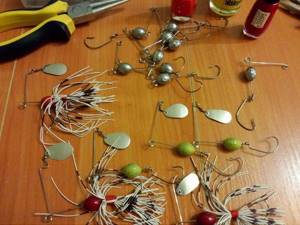
Well, how can you make a high-quality spinnerbait with your own hands without special tools and devices? You will need:
- round nose pliers;
- pliers;
- scissors;
- needle file
Before you start making the bait, you need to decide what size it should be. Now - how to make a catchy spinnerbait:
- Using scissors, you need to cut a “skirt” out of silicone or rubber, and then, using thread, secure it at the base of the jig head.
- From one end of the wire, using pliers, we make a ring and attach a carabiner to it. The jig head with a “skirt” will be attached here.
- We process the edge of the wire loop with a needle file and put a colored cambric on its base.
- Next, having departed the required distance from this place (usually no more than 2 - 2.5 centimeters), you need to bend the wire at a right angle, but in the place of this middle bend, you also need to create a loop using pliers. This is where the spinning line will be attached.
- We string one or two beads onto the free part of the base, then a carabiner with a petal, and then a couple more beads. The beads will act as stoppers for the carabiner with the petal when placing the bait.
- We make a ring at the second end of the wire base. You can attach the second petal to it using a swivel and a winding ring.
That's it, now you know how to make a spinnerbait with two blades using a suitable jig head and some improvised material.
Expert opinion
Knipovich Nikolai Mikhailovich
Zoologist, hydrobiologist. I am interested in fishing at a professional level.
Attention! When making this design with two petals, it is recommended to use petals of different sizes. A petal with a smaller size is installed closer to the middle bend of the wire, and a petal with a larger size is attached to the ring at the end of the wire base.
If you are thinking about how to make a spinnerbait with one blade, then follow the same algorithm, but do not install a small blade on a wire base. Limit yourself to one - attached to a ring. Beads can be installed as desired.
During the process of guiding the spinnerbait, there will be a hook in the skirt in the lower part, and petals will play in the upper part, attracting the attention of the predator.



